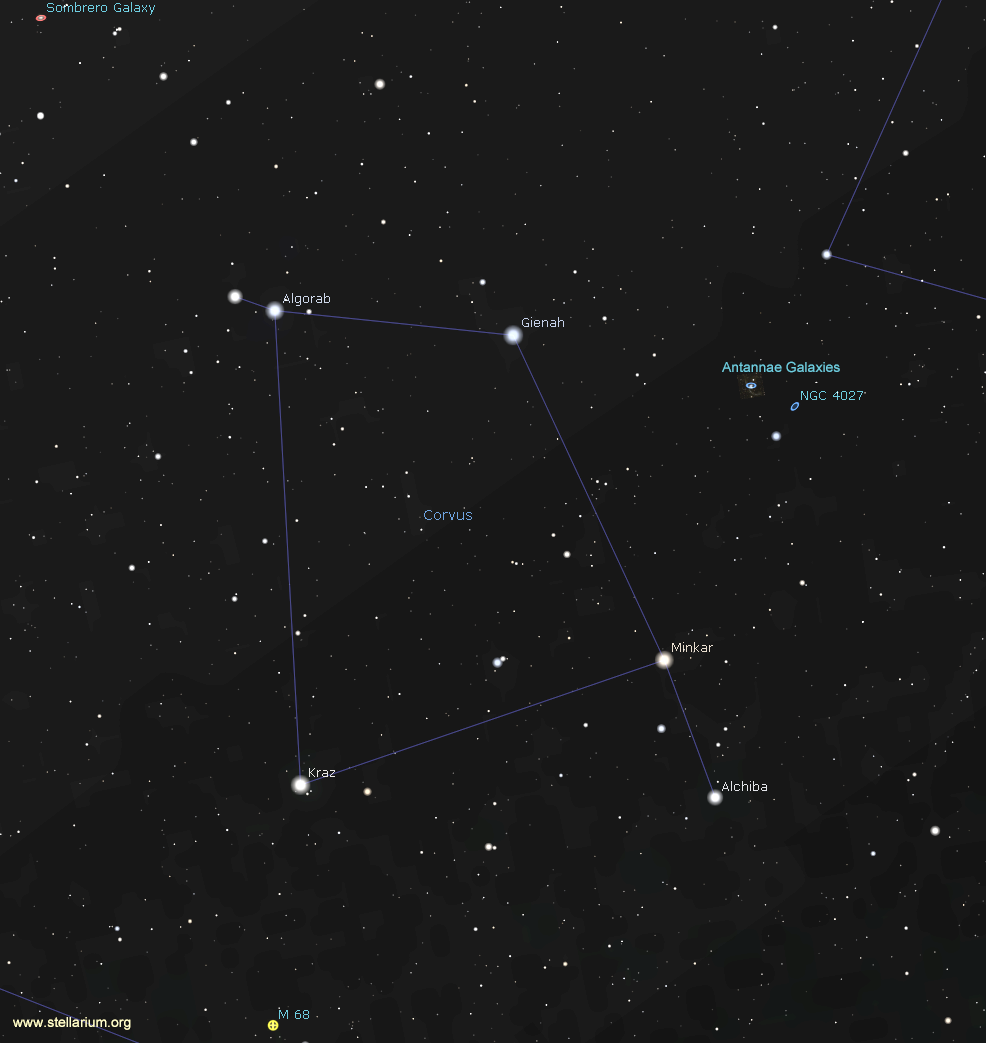Corvus The Crow
Follow the handle of the Big Dipper as it arcs or bends to the star Arcturus in the constellation Bootes. Continue this imaginary curve to the first magnitude star Spica – alpha Virgo. At 250 light-years (ly) away, Spica shines 1,900 times more luminous than the Sun. It actually consists of two extremely hot B1 and B4 stars that are separated by a mere 0.12 astronomical units or 18 million kilometres.
To the lower right of Spica is a trapezoid of stars, this is Corvus. Mythology states the god Apollo sent the crow with a cup (Crater) in search of water. The crow was distracted by a fig tree, which caused its delay to Apollo. On its return, Corvus gave the excuse a water snake (Hydra) prevented the bird from filling the cup. Apollo did not believe this story and cast all three into the night sky forever.

From the top left of the asterism, we see the star called Algorab located 87 ly away. Moving clockwise is Gienah. This is a hot B8 star some 154 ly away and measures four times the diameter of the Sun. Next, we have orange coloured Minkar. It is the farthest of the four at 318 ly away and has ballooned in size to measure two-thirds the orbit of Mercury. And last is the G5 star Kraz. It resides 146 ly away and research shows it was a blue-white B7 star only 300 million years ago.
Corvus has a few targets well worth observing and imaging. First, we have M104 aka the Sombrero Galaxy. This is a lovely lenticular galaxy, almost oriented edge-on and has a very distinct dust lane. The Sombrero is located 31 million ly from us and estimated to be 50 thousand ly in width. Halfway between Corvus and Crater is an unusual spiral catalogued NGC 4027. At 77 million ly away this 11th magnitude galaxy has only one spiral arm.

A classic example of two interacting galaxies is NGC 4038 and 4039 known as the Antennae Galaxies. They are about 80 million ly away and demonstrates the fate of the Milky Way when it collides with the Andromeda galaxy in about four billion years from now. It will be known as Milkomeda.
Speaking about our galaxy the constellation Scorpius with the orange star Antares is above the horizon along with Jupiter by 2 a.m. local time. By 4 a.m. Sagittarius and Saturn can be seen along with the glow of billions of stars of the Milky Way. Follow it up and east, as it connects the Cygnus the Swan aka the “Northern Cross”, a sure sign days and nights will soon be getting warmer.
Mars can be seen now passing the Pleiades and will be closest to the star Aldebaran – the eye of the bull in Taurus on April 9.The annual Lyrid meteor shower peaks on the night of April 23 with an hourly rate of 18 meteors per hour.
The full Pink Moon occurs on April 19 which will definitely interfere with viewing the Lyrids.
Until next month, clear skies everyone.
